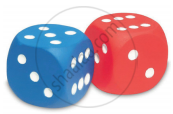Advertisements
Advertisements
Question
Two dice are rolled, find the probability that the sum is less than 13
Solution
Sample space (S) = {(1, 1) (1, 2) (1, 3) (1, 4) (1, 5) (1, 6) (2, 1) (2, 2) (2, 3) (2, 4) (2, 5) (2, 6) (3, 1) (3, 2) (3, 3) (3, 4) (3, 5) (3, 6) (4, 1) (4, 2) (4, 3) (4, 4) (4, 5) (4, 6) (5, 1) (5, 2) (5, 3) (5, 4) (5, 5) (5, 6) (6, 1) (6, 2) (6, 3) (6, 4) (6, 5) (6, 6)}
n(S) = 36
Let E3 be the event of getting the sum is less than 13
n(E3) = 36
p(E3) = `("n"("E"_3))/("n"("S"))`
= `36/36`
= 1
APPEARS IN
RELATED QUESTIONS
In a hockey team, there are 6 defenders, 4 offenders, and 1 goalee. Out of these, one player is to be selected randomly as a captain. Find the probability of the selection that – The goalee will be selected.
A bag contains cards numbered from 1 to 49. A card is drawn from the bag at random, after mixing the card thoroughly. Find the probability that the number on the drawn card is a perfect square
Cards numbered from 11 to 60 are kept in a box. If a card is drawn at random from the box, find the probability that the number on the drawn card is divisible by 5
All kings and queens are removed from a pack of 52 cards. The remaining cards are well shuffled and then a card is randomly drawn from it. Find the probability that this card is a black card.
Red queens and black jacks are removed from a pack of 52 playing cards. A card is drawn at random from the remaining cards, after reshuffling them. Find the probability that the card drawn is a queen
Which of the following cannot be the probability of an event?
A jar contains 54 marbles, each of which some are blue, some are green and some are white. The probability of selecting a blue marble at random is `1/3` and the probability of selecting a green marble at random is `4/9`. How many white marbles does the jar contain?
In a certain race, there are three boys X,Y, Z. The winning probability of X is twice than Y and the winning probability of Y is twice than Z. If P(X) + P(Y) + P(Z) = 1, then find the winning probability of each girl.
In a single throw of a die, find the probability of getting :
(i) 8
(ii) a number greater than 8
(iii) a number less than 8
On throwing a dice once, the probability of occurence of a composite number is `1/2`.
